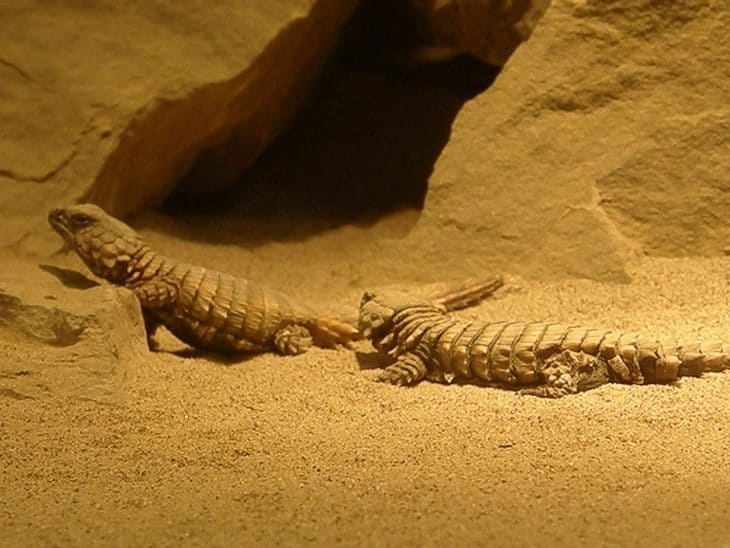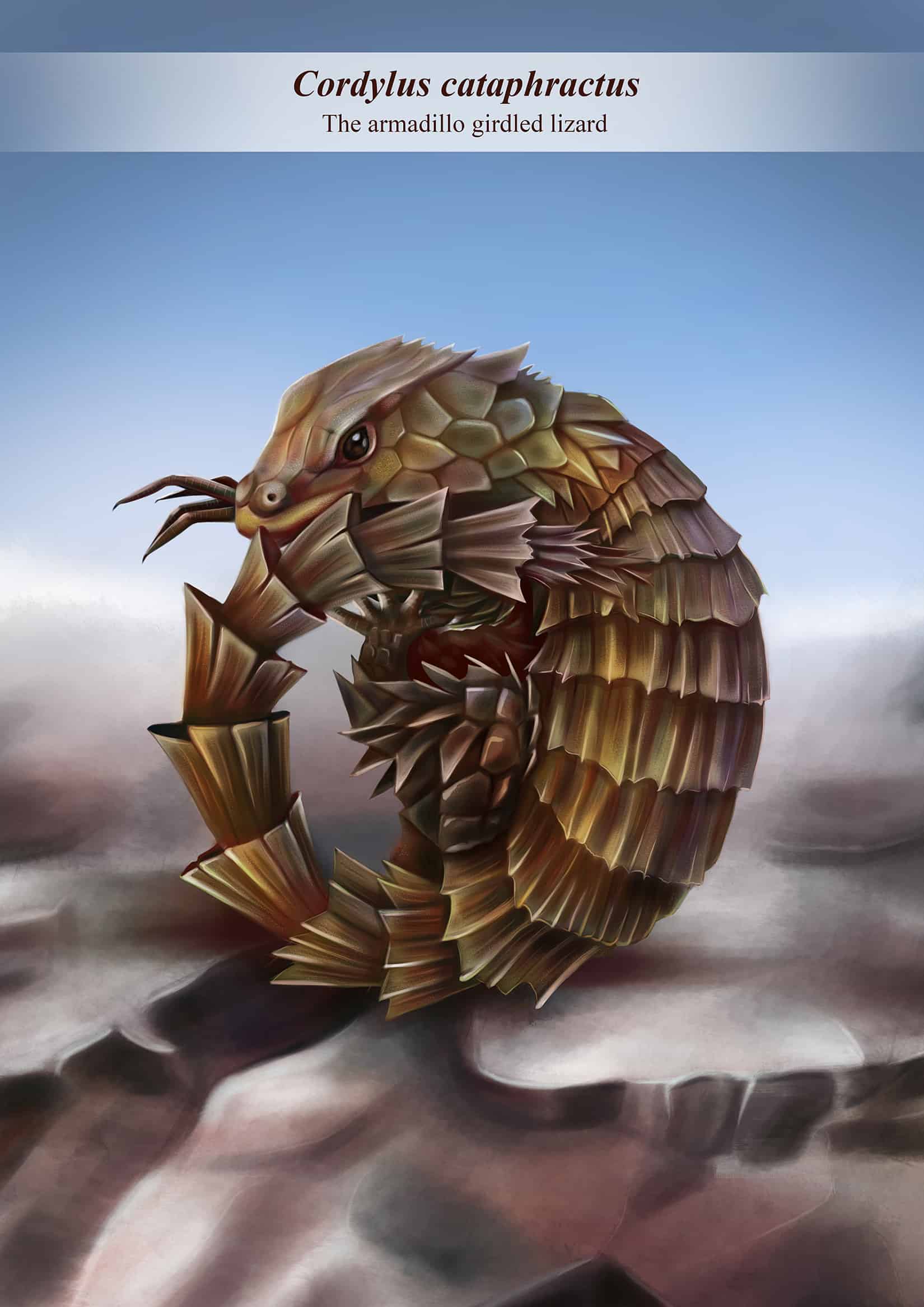
Named after bigger armored mammals, the armadillo lizard is a unique species of its own. Native to South Africa, people have compared these lizards to the Greek ouroboros for its defensive stance. However, they hold many other wonders behind their armor. Find out more about these rare animals with these armadillo lizard facts.
- Armadillo lizards can grow up to 10.5 cm long.
- Their tails can grow longer than their bodies, measuring up to 40 cm.
- They can reach a weight of up to 8 kg.
- Their general appearance makes them look like really small dragons.
- While their lifespan in the wild remains unknown, they can live for up to 25 years in captivity.
- Armadillo lizards have a distinctively-triangular head.
- They also have distinctively-flattened bodies and tails.
- Their front legs also grow much longer than their hind legs do.
- They call the west coast of South Africa home.
- The lizards aren’t nocturnal, instead staying awake during the day.
- They were once harvested for sale as exotic pets.
- Today, it’s illegal in South Africa to keep the lizards as pets.
- International organizations once listed the lizards as a vulnerable species.
- In 1996, though, they reclassified the lizards as of least concern.
- The lizards can bite people, and flick their tongues at intruders as a warning to leave.
- The full name of the species actually is armadillo girdled lizard.
- Other names for the species include golden armadillo lizard and armadillo spiny-tailed lizard.
- Armadillo lizards are cold-blooded animals.
- They can deliver a powerful bite that can break their own jaws.
- Like other lizards, they can cut off their tails to distract predators and escape.
Armadillo lizards aren’t related in any way to armadillos
Despite what their names may suggest, these lizards have nothing to do with armadillos. For one thing, the lizards are reptiles – a completely different class of life compared to armadillos. In contrast, armadillos belong to the class of mammals, just like humans do. The only similarity between the two lies in the hard armor covering their bodies as well as their defensive stance.
Armadillo lizards have hard scales.
This armor serves as their main protection from predators, changing in color from one part of their body to another. On their upper bodies, armadillo lizard’s armor end to have shades of brown, while the scales on the lower body usually have yellow tones.
The scales on the lizards’ lips have a brown color, while those on their chins have black splotches. Scientists believe that this color scheme works as camouflage for the lizards, helping them blend into their environment.
Armadillo lizards are omnivores.
With termites as their staple food, armadillo lizards prefer meat. In fact, these lizards travel as far as 60 meters just to break into a termite nest and eat the insects inside. While 60 meters might not mean much to us humans, that’s quite the distance for smaller animals. In addition to termites, they also eat spiders and other insects. Scientists have also seen these lizards eat leaves from low bushes and shrubs.
Armadillo lizards have few predators.
Their armored scales and hardened spines tend to make most other animals avoid them. However, birds of prey like falcons and eagles can still hunt them perfectly fine. In fact, birds of prey make up the natural predators of the armadillo lizard.
Armadillo lizards curl up into a ball to protect themselves from danger.
To reinforce this stance, armadillo lizards stick their tails into their mouths and bite down. This lets them present armored scales and hardened spines in all directions they might get attacked from. They can even spend hours in such a state until they’re sure that all danger has come and gone.
Interestingly, in such a state, they also resemble the ouroboros, a mythical serpent that eats its own tail. In alchemy and magic, the ouroboros symbolizes cycles, infinity, and the circle of life and death.

Armadillo lizards are social animals.
They live in large groups, typically formed of around 30 animals to 60 animals. This also allows the lizards to take advantage of strength in numbers. In these groups, seeing these animals curl up is definitely a sight to behold.
Armadillo lizards mate in the spring.
Although they like being in groups, most armadillo lizards don’t go far to find mates. In fact, males can get territorial when it gets to mating, chasing away any males from other groups that come too close. That said, the lizards don’t have fixed mating pairs, with anyone free to mate each season.
Armadillo lizards don’t lay eggs.
Instead of laying eggs, this species is one of the only lizards that give birth to live young. Females give birth to up to two lizard babies at a time. Unlike most other lizards, this species also tends to feed their young.
Armadillo lizards face many environmental problems.
For one, the planet’s rising temperatures can cause bigger wildfires, making it more difficult to control. This naturally poses a direct threat to the lizards, as they will burn to death in a wildfire. Invasive plant species can also upset their food supply, as they find themselves having to eat plant life they haven’t adapted to.
Armadillo lizards have specific requirements as pets.
In South Africa, it’s illegal to keep armadillo lizards as pets. However, that isn’t the case in countries overseas. For the ideal tank, professionals recommend at least 20 gallons of empty space inside, with a screen top to allow air to move freely. Temperatures also need to keep within 29 to 49°C to keep the lizards in the tank comfortable. Ample water should also be available, replaced daily to keep it clean. An armadillo lizard’s diet in captivity typically includes crickets and worms.
Was this page helpful?
Our commitment to delivering trustworthy and engaging content is at the heart of what we do. Each fact on our site is contributed by real users like you, bringing a wealth of diverse insights and information. To ensure the highest standards of accuracy and reliability, our dedicated editors meticulously review each submission. This process guarantees that the facts we share are not only fascinating but also credible. Trust in our commitment to quality and authenticity as you explore and learn with us.
